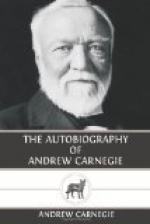EDUCATIONAL AND PENSION FUNDS
The fifteen-million-dollar pension fund for aged university professors (The Carnegie Endowment for the Advancement of Learning), the fourth important gift, given in June, 1905, required the selection of twenty-five trustees from among the presidents of educational institutions in the United States. When twenty-four of these—President Harper, of Chicago University, being absent through illness—honored me by meeting at our house for organization, I obtained an important accession of those who were to become more intimate friends. Mr. Frank A. Vanderlip proved of great service at the start—his Washington experience being most valuable—and in our president, Dr. Henry S. Pritchett, we found the indispensable man.
This fund is very near and dear to me—knowing, as I do, many who are soon to become beneficiaries, and convinced as I am of their worth and the value of the service already rendered by them. Of all professions, that of teaching is probably the most unfairly, yes, most meanly paid, though it should rank with the highest. Educated men, devoting their lives to teaching the young, receive mere pittances. When I first took my seat as a trustee of Cornell University, I was shocked to find how small were the salaries of the professors, as a rule ranking below the salaries of some of our clerks. To save for old age with these men is impossible. Hence the universities without pension funds are compelled to retain men who are no longer able, should no longer be required, to perform their duties. Of the usefulness of the fund no doubt can be entertained.[48] The first list of beneficiaries published was conclusive upon this point, containing as it did several names of world-wide reputation, so great had been their contributions to the stock of human knowledge. Many of these beneficiaries and their widows have written me most affecting letters. These I can never destroy, for if I ever have a fit of melancholy, I know the cure lies in re-reading these letters.
[Footnote 48: The total amount of this fund in 1919 was $29,250,000.]
My friend, Mr. Thomas Shaw (now Lord Shaw), of Dunfermline had written an article for one of the English reviews showing that many poor people in Scotland were unable to pay the fees required to give their children a university education, although some had deprived themselves of comforts in order to do so. After reading Mr. Shaw’s article the idea came to me to give ten millions in five per cent bonds, one half of the L104,000 yearly revenue from it to be used to pay the fees of the deserving poor students and the other half to improve the universities.




